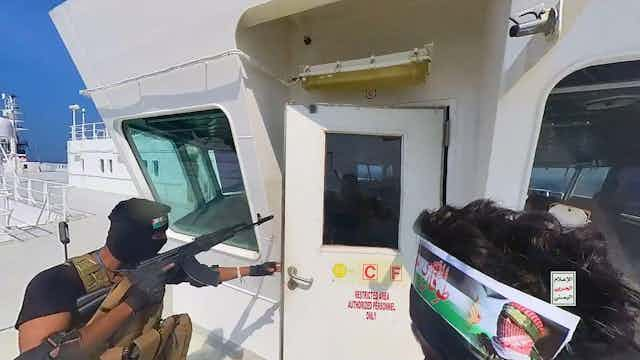The US is reportedly considering strikes against Houthi rebels in Yemen that have been menacing commercial ships in the Red Sea since the conflict began in Gaza. The Pentagon has a range of options for missile attacks on Houthi positions and has moved the Dwight D. Eisenhower carrier strike group into position off the coast of Yemen.
Since November 2023, the Iran-backed Houthis have conducted several attacks on commercial shipping in the Red Sea. Their attacks have increased navigation risks in the region and affected risk perception in the maritime sector. The economic and geopolitical implications are felt much beyond the coast of Yemen.
The world economy is strongly dependent on the global maritime supply chain. About 80% of international trade by volume is transported by sea. This figure rises to 95% for the UK. From mobile phones to clothes and from coffee to sugar, the manufactured items we use and the food we consume on a daily basis have been, at least in part, transported by sea.
Supply chain vulnerabilities
It does not take much to disrupt the global maritime supply chain. For instance, a simple accident that blocked the Suez Canal for six days in 2021 or the shortage of labour in Chinese ports during the COVID pandemic have been enough to negatively affect maritime supply chains and the global economy.
Intentional disruptions of the maritime supply chain by pirates or terrorists pose a challenge that goes beyond simple logistics.
Attacks on civilian shipping directly affect insurance premiums and deter operators from transiting through certain areas for financial and security reasons. The private maritime sector is not immune to geopolitics, and higher insurance premiums or the cost of rerouting ships eventually trickle down to consumers.
Piracy is a for-profit criminal activity that has disrupted maritime trade for decades, especially in eastern and western Africa. States have devoted substantial resources to deter and combat pirates, both at sea (for example deploying a naval task force to patrol shipping lanes) and on land to address the underlying socioeconomic causes of piracy.
Politically motivated groups, including terrorist organisations, pose a different type of threat. Their primary objective is not to make money but to increase the visibility of their organisation, or to exercise leverage on other political actors at the regional or global level.
This is achieved by conducting attacks that increase risk and risk perception in a given area, disrupt maritime supply chains, and have disproportionate impacts on the geopolitical situation.
Limited options
The Houthis are politically motivated. Their attacks aim to have an impact on the war in Gaza. Their location along a major sea lane of communication in the Red Sea gives them an asymmetrical advantage when it comes to attacking commercial shipping.

Major shipping companies and operators, from Maersk to BP, have paused operations in the Red Sea. Oil prices are expected to rise. Consequently, Houthis’ attacks affect commerce and the economy much beyond the Red Sea. But options to address the threat are limited.
Politically motivated groups are more difficult to deter than pirates, because they are often willing to die for their cause. They are not looking for a ransom or bounty, but are trying to destroy or damage ships and disrupt shipping, so deploying vessel protection detachments or private security companies personnel onboard will have minimal or no effect.

Military response
Failing to deter Houthis from attacking commercial shipping, the second-best option is to increase naval presence to patrol the Red Sea. But this is not without political risks, since a further militarisation of the crisis might be used by the Houthis and others to inflame the geopolitical situation in Yemen and in the whole region.
As part of what it has called “Operation Prosperity Guardian”, the US has assembled an international naval task force – including UK naval assets – which will have capabilities to intercept missiles and defend commercial shipping in case of an attack.
But, with a limited number of warships to patrol a large area and with early warning time for missile attacks limited due to the proximity of Yemen, it will be difficult to successfully defend against absolutely all attacks and prevent any damage from occurring.
That said, the symbolic value of such a task force is important. The task force’s success will be evaluated based on its ability in the short-term to add to existing mechanisms to reassure insurers, operators and global markets that the route is safe enough for shipping operations, without risking military escalation in an extremely turbulent region.

